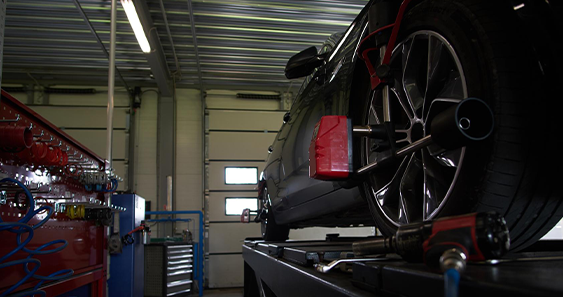Wheel alignment can ensure that your vehicle is road-safe and easy to handle. Many minor and major vehicle incidents are actually related to wheel misalignment issues.
At Lancashire ADAS, we are experts of all things wheel alignment, and this blog post contains everything you need to know.
What is wheel alignment?
Wheel alignment involves a mechanic adjusting a vehicle’s suspension and steering system, to return handling and vehicle performance to its intended state. Adjusting the angles of the wheels in relation to each other based on camber, toe, and caster, will ensure your vehicle doesn’t suffer with any drift issues or extra tyre strain.
You shouldn’t perform a wheel alignment yourself (unless you’re a professional), as it is a highly technical process, and the repercussions of an unprofessional or unreliable job could be very dangerous.
Types of wheel alignment
There are two main types of wheel alignment, known as two-wheel alignment (thrust angle alignment), or four-wheel alignment.
Two-wheel alignment of course focuses on just two wheels on your vehicle, usually the front two. During this process, camber, toe and caster angles are tweaked to restore alignment.
A four-wheel alignment is more common, as most vehicles today are four wheel drives. Most passenger cars, SUVs, and vans are equipped with four wheel drive. Four-wheel alignment means that your mechanic will first adjust the front suspension and steering, then do the same for the back.
After either type of alignment, you’ll feel a noticeable difference in steering and handling for your vehicle, your tyres will last longer, and your car should consume less fuel.

When do I need wheel alignment?
You should get a wheel alignment at least once a year, we recommend this for safety and convenience reasons. Also, if you leave it too long in between alignments, the job will likely be a lot more difficult and lengthy, as more issues may have accumulated and the alignment might be more difficult.
On top of this, you should consider getting a wheel alignment if you experience any of the following:
- Steering wheel issues – Problems such as an off-centre wheel, or a shaking/vibrating steering wheel whilst driving, could be warning signs of alignment or steering issues which an alignment should solve.
- Tyre wear – If you notice your tyres wearing faster than they should, or some tyres becoming worn faster than others, you can safely assume that alignment is part of the problem. Extra wear on either the inner or outer of your tyres are a strong indication of alignment issues.
- Unusual noises – Misaligned wheels cause extra strain on the tyres and the steering system as a whole. A by-product of this is often loud squeaking or other unusual noises. If you notice any strange noises, consider speaking to a professional about your options.
- Drifting – Possibly one of the most telltale signs of misalignment is drifting. If you notice your vehicle consistently drifting slowly to one side (without your input), it is very likely that you need an urgent alignment.
During an alignment, your mechanic will adjust the vehicle’s suspension and steering for camber, toe, and caster.
Camber, toe, and caster
Camber, toe and caster are the three main aspects mechanics are concerned with regarding alignment.
Camber refers to the in/outward angle of your wheel as viewed from the front end of the vehicle. Inward tilt is known as negative camber, whilst outward title is known as positive camber, and these issues can be caused by worn bearings or ball joints.
Toe alignment is how far your wheels or tyres point inward or outward by default, as viewed from above the vehicle. ‘Toe-in’ alignment is, naturally, when both tires are pointed inwards. Similarly, both tires being pointed outwards is known as ‘toe-out’ alignment.
Caster is the angle of your steering axis as viewed from the side of your vehicle. Negative caster means the top of the wheel will point to the front of the car, whilst positive caster will point towards the back. This angle is important for balancing stability and cornering, as well as steering.

Wheel alignment near me
If you’re based in the Lancashire area and you are looking for a high quality, low cost wheel alignment service, you’ve come to the right place. We also pride ourselves on getting a quality job done in a timely manner.
With Lancashire ADAS, your alignment generally won’t take longer than an hour, and we’d estimate around 30 minutes on average.
Wheel alignment doesn’t need to be a long process nine times out of ten, and our technicians will ensure that everything is done safely and properly before finishing the process.

